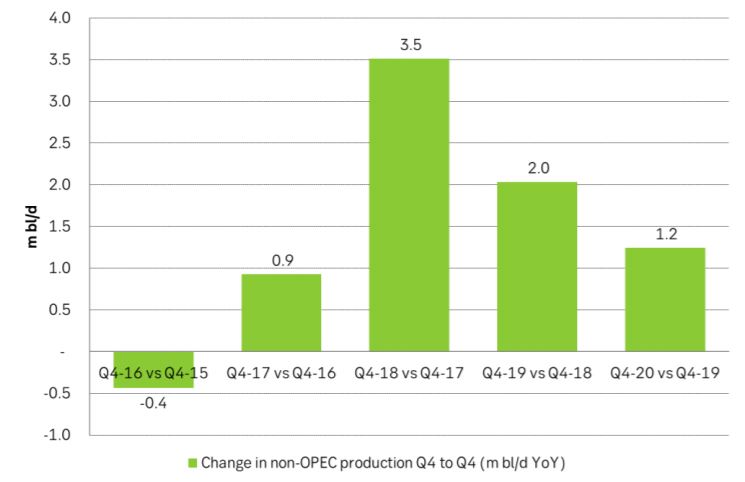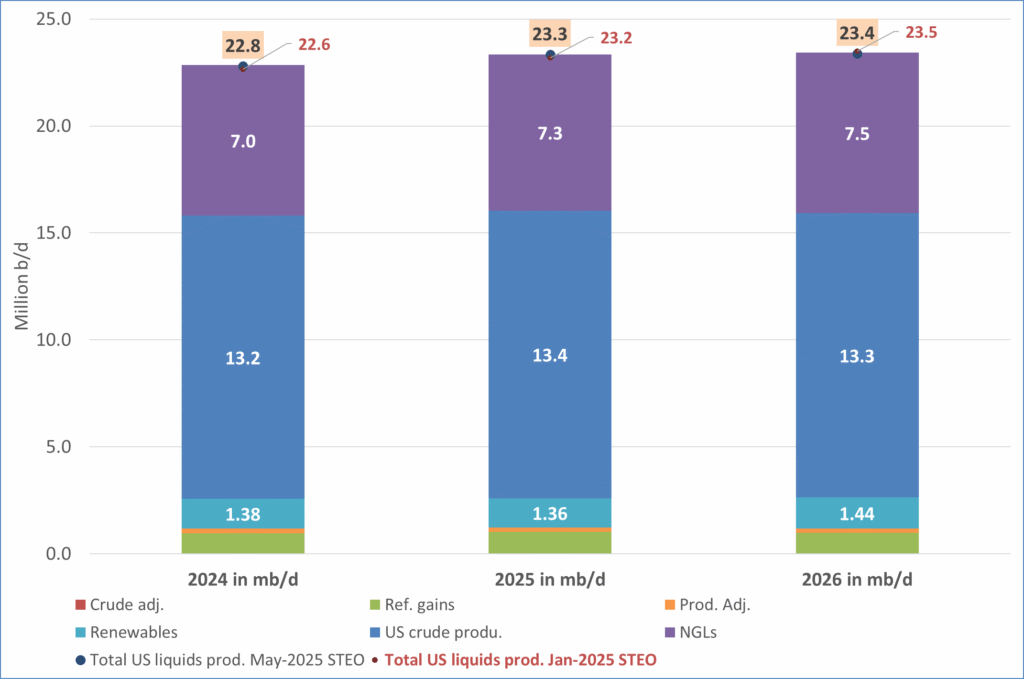Analys
Not a single drop of US blood or mid-east oil


After having spiked to almost $72/bl at the start of the year the Brent crude oil price has now fallen back to $65.3/bl. Left, right and centre analysts are stating that we have probably now already seen the oil-price-high of 2020. That could of course turn out to be true, but it goes without saying that it is way, way too early to make such a conclusion as we after all still has 357 days left of the year to go. We are also seeing long lists of why the oil price spike could not last and why it is impossible for the oil price to move higher. The simple reason for why the oil price has fallen back and did not lift higher is of course that we have not lost a single drop of US blood or a single drop of mid-east oil yet. What is clear though is that the risk of loosing supplies in the middle east in 2020 is now higher than it was before the killing of Qassem Soleimani.

Also, through the second half of 2019 there was an almost endless gloom and doom with respect to the oil market outlook for 2020. This may of course turn out to be true, but the fact is that only after a few days into the new year we already have had the Brent crude oil price trading close to $72/bl. What OPEC+ knows very well is that what matters for the oil price is first and foremost how much oil there is above ground and not how big the resources are in the ground (because they are in principle almost endless). If OPEC+ sticks to its strategy of “price over volume” and the global economy does not fall off a cliff then the endless numbers of bearish scenarios for 2020 oil will most likely not come through.
What helps OPEC+ out in 2020 is the projection that non-OPEC production growth from Q4-19 to Q4-20 is projected to grow at the slowest pace in three years due to a projected sharp deceleration of U.S. shale oil production. This makes it much easier for OPEC+ to manage the situation. Looking at the balance for 2020 it should be well within the capability of OPEC+ to manage the oil market through the year with a “price over volume” all the way through. They clearly can, the key question is more whether they want to or not.
In this respect the latest statement from Russia at the end of December is worrisome. Russia’s Energy Minister Aleksander Novak on 27 December: “Oil-production cuts can’t be eternal; we will gradually need to make a decision on exiting. Russia needs to defend its market share and let its oil companies develop new projects”.
Russia (Putin) has however spent a lot of time and effort to nurture and develop a fruitful relationship with Saudi Arabia over the latest years. What stands out looking at the oil market balance projected for 2020 by the US EIA, IEA and OPEC is that oil market surplus is mostly about the first six months of the year with mostly a balanced market for the second half. So even if the current OPEC+ deal only is agreed to the end of Q1-20 it would be a big surprise to us if Russia decides to throw away a good relationship with Saudi Arabia when all that is needed is to carry the cuts also through Q2-20.
In our view it thus looks like a fair assumption/bet that OPEC+ will carry on with its “price over volume” strategy also in Q2-20 and then the second half of 2020 should not be all that much of a problem.
Short term though the global growth revival optimism and weakening USD we witnessed in Q4-19 which helped to carry the Brent crude oil price from $57/bl at the end of September to $68/bl in late December has started to wither a little. Net long speculative positions in crude oil also built up considerably through Q4-19. So, an oil price pull-back due to a net long speculative unwind is not unlikely in the shorter term.
So far this year we have had some serious middle east jitters but with no losses of US blood or middle east oil. Further serious events in 2020 are highly likely in our view and the risk for losses of US blood and middle east oil is significant.
Ch1: US EIA projection and historical values of non-OPEC oil production change from Q4 to Q4 in m bl/d. From Q4-19 to Q4-20 non-OPEC production is projected to grow at the slowest pace in three years.

Analys
Brent crude ticks higher on tension, but market structure stays soft

Brent crude has climbed roughly USD 1.5-2 per barrel since Friday, yet falling USD 0.3 per barrel this mornig and currently trading near USD 67.25/bbl after yesterday’s climb. While the rally reflects short-term geopolitical tension, price action has been choppy, and crude remains locked in a broader range – caught between supply-side pressure and spot resilience.

Prices have been supported by renewed Ukrainian drone strikes targeting Russian infrastructure. Over the weekend, falling debris triggered a fire at the 20mtpa Kirishi refinery, following last week’s attack on the key Primorsk terminal.
Argus estimates that these attacks have halted ish 300 kbl/d of Russian refining capacity in August and September. While the market impact is limited for now, the action signals Kyiv’s growing willingness to disrupt oil flows – supporting a soft geopolitical floor under prices.
The political environment is shifting: the EU is reportedly considering sanctions on Indian and Chinese firms facilitating Russian crude flows, while the U.S. has so far held back – despite Bessent warning that any action from Washington depends on broader European participation. Senator Graham has also publicly criticized NATO members like Slovakia and Hungary for continuing Russian oil imports.
It’s worth noting that China and India remain the two largest buyers of Russian barrels since the invasion of Ukraine. While New Delhi has been hit with 50% secondary tariffs, Beijing has been spared so far.
Still, the broader supply/demand balance leans bearish. Futures markets reflect this: Brent’s prompt spread (gauge of near-term tightness) has narrowed to the current USD 0.42/bl, down from USD 0.96/bl two months ago, pointing to weakening backwardation.
This aligns with expectations for a record surplus in 2026, largely driven by the faster-than-anticipated return of OPEC+ barrels to market. OPEC+ is gathering in Vienna this week to begin revising member production capacity estimates – setting the stage for new output baselines from 2027. The group aims to agree on how to define “maximum sustainable capacity,” with a proposal expected by year-end.
While the IEA pegs OPEC+ capacity at 47.9 million barrels per day, actual output in August was only 42.4 million barrels per day. Disagreements over data and quota fairness (especially from Iraq and Nigeria) have already delayed this process. Angola even quit the group last year after being assigned a lower target than expected. It also remains unclear whether Russia and Iraq can regain earlier output levels due to infrastructure constraints.
Also, macro remains another key driver this week. A 25bp Fed rate cut is widely expected tomorrow (Wednesday), and commodities in general could benefit a potential cut.
Summing up: Brent crude continues to drift sideways, finding near-term support from geopolitics and refining strength. But with surplus building and market structure softening, the upside may remain capped.
Analys
Volatile but going nowhere. Brent crude circles USD 66 as market weighs surplus vs risk

Brent crude is essentially flat on the week, but after a volatile ride. Prices started Monday near USD 65.5/bl, climbed steadily to a mid-week high of USD 67.8/bl on Wednesday evening, before falling sharply – losing about USD 2/bl during Thursday’s session.

Brent is currently trading around USD 65.8/bl, right back where it began. The volatility reflects the market’s ongoing struggle to balance growing surplus risks against persistent geopolitical uncertainty and resilient refined product margins. Thursday’s slide snapped a three-day rally and came largely in response to a string of bearish signals, most notably from the IEA’s updated short-term outlook.
The IEA now projects record global oversupply in 2026, reinforcing concerns flagged earlier by the U.S. EIA, which already sees inventories building this quarter. The forecast comes just days after OPEC+ confirmed it will continue returning idle barrels to the market in October – albeit at a slower pace of +137,000 bl/d. While modest, the move underscores a steady push to reclaim market share and adds to supply-side pressure into year-end.
Thursday’s price drop also followed geopolitical incidences: Israeli airstrikes reportedly targeted Hamas leadership in Doha, while Russian drones crossed into Polish airspace – events that initially sent crude higher as traders covered short positions.
Yet, sentiment remains broadly cautious. Strong refining margins and low inventories at key pricing hubs like Europe continue to support the downside. Chinese stockpiling of discounted Russian barrels and tightness in refined product markets – especially diesel – are also lending support.
On the demand side, the IEA revised up its 2025 global demand growth forecast by 60,000 bl/d to 740,000 bl/d YoY, while leaving 2026 unchanged at 698,000 bl/d. Interestingly, the agency also signaled that its next long-term report could show global oil demand rising through 2050.
Meanwhile, OPEC offered a contrasting view in its latest Monthly Oil Market Report, maintaining expectations for a supply deficit both this year and next, even as its members raise output. The group kept its demand growth estimates for 2025 and 2026 unchanged at 1.29 million bl/d and 1.38 million bl/d, respectively.
We continue to watch whether the bearish supply outlook will outweigh geopolitical risk, and if Brent can continue to find support above USD 65/bl – a level increasingly seen as a soft floor for OPEC+ policy.
Analys
Waiting for the surplus while we worry about Israel and Qatar

Brent crude makes some gains as Israel’s attack on Hamas in Qatar rattles markets. Brent crude spiked to a high of USD 67.38/b yesterday as Israel made a strike on Hamas in Qatar. But it wasn’t able to hold on to that level and only closed up 0.6% in the end at USD 66.39/b. This morning it is starting on the up with a gain of 0.9% at USD 67/b. Still rattled by Israel’s attack on Hamas in Qatar yesterday. Brent is getting some help on the margin this morning with Asian equities higher and copper gaining half a percent. But the dark cloud of surplus ahead is nonetheless hanging over the market with Brent trading two dollar lower than last Tuesday.

Geopolitical risk premiums in oil rarely lasts long unless actual supply disruption kicks in. While Israel’s attack on Hamas in Qatar is shocking, the geopolitical risk lifting crude oil yesterday and this morning is unlikely to last very long as such geopolitical risk premiums usually do not last long unless real disruption kicks in.
US API data yesterday indicated a US crude and product stock build last week of 3.1 mb. The US API last evening released partial US oil inventory data indicating that US crude stocks rose 1.3 mb and middle distillates rose 1.5 mb while gasoline rose 0.3 mb. In total a bit more than 3 mb increase. US crude and product stocks usually rise around 1 mb per week this time of year. So US commercial crude and product stock rose 2 mb over the past week adjusted for the seasonal norm. Official and complete data are due today at 16:30.
A 2 mb/week seasonally adj. US stock build implies a 1 – 1.4 mb/d global surplus if it is persistent. Assume that if the global oil market is running a surplus then some 20% to 30% of that surplus ends up in US commercial inventories. A 2 mb seasonally adjusted inventory build equals 286 kb/d. Divide by 0.2 to 0.3 and we get an implied global surplus of 950 kb/d to 1430 kb/d. A 2 mb/week seasonally adjusted build in US oil inventories is close to noise unless it is a persistent pattern every week.
US IEA STEO oil report: Robust surplus ahead and Brent averaging USD 51/b in 2026. The US EIA yesterday released its monthly STEO oil report. It projected a large and persistent surplus ahead. It estimates a global surplus of 2.2 m/d from September to December this year. A 2.4 mb/d surplus in Q1-26 and an average surplus for 2026 of 1.6 mb/d resulting in an average Brent crude oil price of USD 51/b next year. And that includes an assumption where OPEC crude oil production only averages 27.8 mb/d in 2026 versus 27.0 mb/d in 2024 and 28.6 mb/d in August.
Brent will feel the bear-pressure once US/OECD stocks starts visible build. In the meanwhile the oil market sits waiting for this projected surplus to materialize in US and OECD inventories. Once they visibly starts to build on a consistent basis, then Brent crude will likely quickly lose altitude. And unless some unforeseen supply disruption kicks in, it is bound to happen.
US IEA STEO September report. In total not much different than it was in January

US IEA STEO September report. US crude oil production contracting in 2026, but NGLs still growing. Close to zero net liquids growth in total.

-

 Nyheter4 veckor sedan
Nyheter4 veckor sedanMahvie Minerals är verksamt i guldrikt område i Finland
-

 Analys4 veckor sedan
Analys4 veckor sedanIncreasing risk that OPEC+ will unwind the last 1.65 mb/d of cuts when they meet on 7 September
-

 Nyheter4 veckor sedan
Nyheter4 veckor sedanNeil Atkinson spår att priset på olja kommer att stiga till 70 USD
-

 Nyheter2 veckor sedan
Nyheter2 veckor sedanEurobattery Minerals satsar på kritiska metaller för Europas självförsörjning
-

 Analys3 veckor sedan
Analys3 veckor sedanOPEC+ in a process of retaking market share
-

 Nyheter2 veckor sedan
Nyheter2 veckor sedanGuldpriset kan närma sig 5000 USD om centralbankens oberoende skadas
-

 Nyheter1 vecka sedan
Nyheter1 vecka sedanMahvie Minerals i en guldtrend
-

 Nyheter3 veckor sedan
Nyheter3 veckor sedanNytt produktionsrekord av olja i USA, högsta efterfrågan på 20 år







